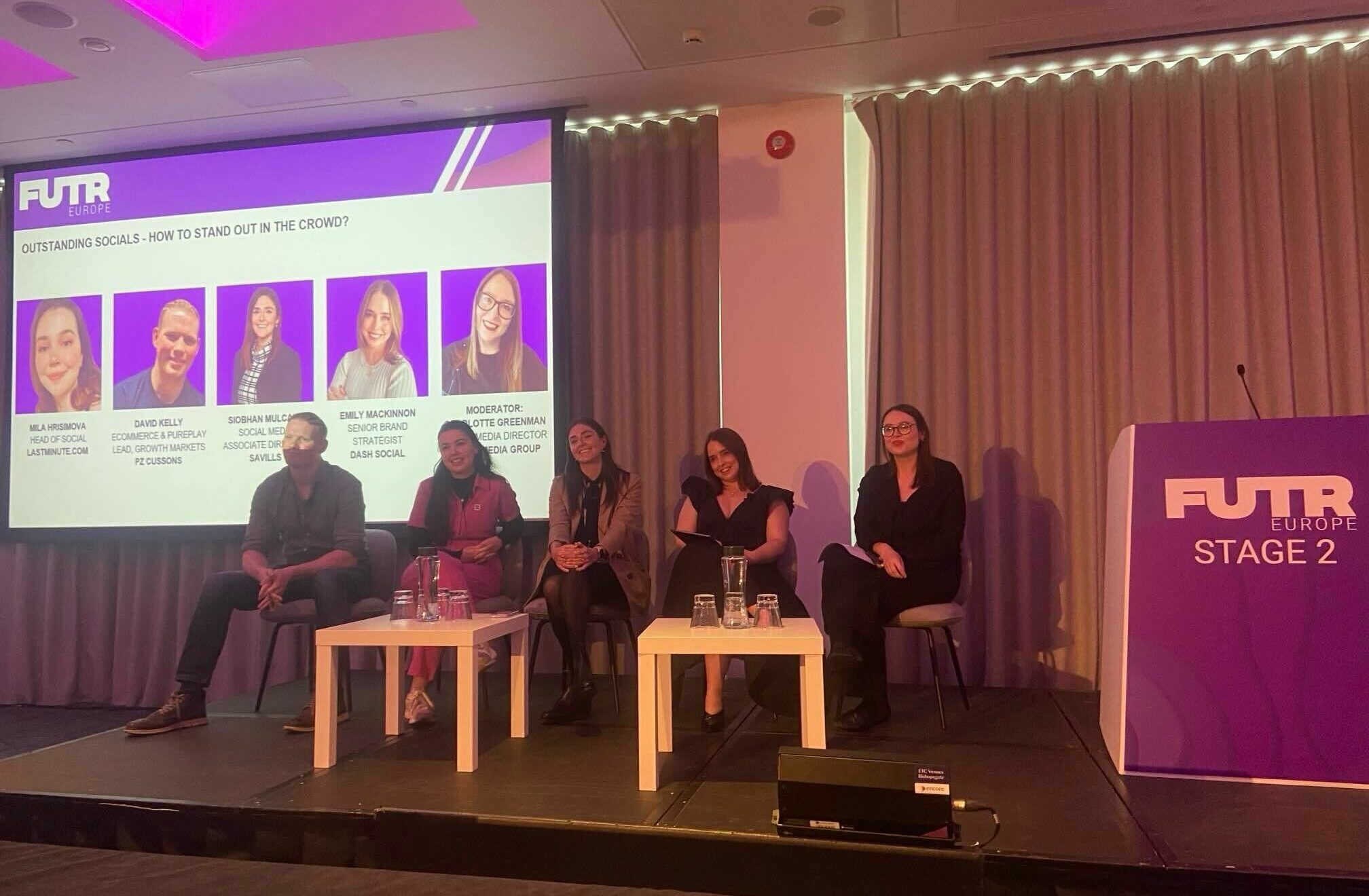
Photo: RetailWire
May 1, 2025
From Followers to Community: How Smart Brands Are Winning on Social
Some of the leading minds in the digital marketing space came together to share insights into how brands are successfully navigating the evolving landscape of social media and community building.
The discussion took place during a recent panel discussion at FUTR Europe, moderated by Charlotte Greenman, social media director at Bauer Media Group. Panelists Mila Hrisimova, head of social media at lastminute.com; Emily MacKinnon, senior strategic account manager at Dash Social; Siobhan Mulcahy, social media associate director at Savills; and David Kelly, e-commerce & marketplace director at PZ Cussons tackled the key issues facing brands today: consumer sentiment, content strategy, and the shift from followers to building a sense of community.
The Power of Community Engagement
Greenman kicked off the discussion by highlighting how important it is for brands to not only listen to their consumers but to actively engage with them. This means taking the initiative to respond to every comment and review, which creates an opportunity to build relationships and invest in their community.
According to MacKinnon, the most successful brands today are those that adopt a “community-first” mindset. She explained that brands are increasingly using social media comments to guide their content and are placing community at the forefront. By letting their audiences in and actively engaging with them, these brands create an environment where success can really take off.
Storytelling: The Key to Organic Content
Mulcahy shared an insightful example of a recent campaign with Savills, emphasizing that when brands put the consumer first and let them tell the story, the content performs better. This aligns with the growing trend of creating organic content that resonates emotionally with audiences. Hrisimova noted that understanding what the target audience wants to see — whether it’s humor or educational content — helps them create intentional content that’s truly meaningful.
Mulcahy also stressed the importance of making an impact in the first few seconds of your content. Social media is no longer just about selling; it’s about telling a story in a way that feels authentic and engaging. “Consumers are smart, and they can sniff out a promotion,” she said. Showing behind-the-scenes footage or creating content that blends seamlessly with platform trends can help create a more natural connection.
User-Generated Content: A Trust-Building Tool
Kelly talked about how user-generated content (UGC) is one of the most powerful tools for brands looking to build trust with their audience. He shared how PZ Cussons’ brand Childs Farm encourages real-life examples and consumer stories to help them build a community of advocates. “Consumers want to hear from other consumers. Their stories become the brand’s story,” he said.
Mulcahy added that UGC is most effective when used strategically and authentically. It’s not just about sharing anything; it’s about understanding your brand’s voice and incorporating UGC when it aligns with your messaging. Both Mulcahy and MacKinnon agreed that UGC is a great way to save on content creation while simultaneously building trust with your audience.
The Importance of Experimenting and Evolving
One of the most insightful points of the discussion came when MacKinnon talked about the constant need to adapt and experiment. Hrisimova expanded on the point by sharing how lastminute.com does AB testing with organic social content to identify what hooks, captions, and types of content resonate with their audience. This iterative approach allows the brand to adjust based on performance and ensures that its content is always relevant and engaging.
She echoed the same sentiment as MacKinnon, explaining that brands should take advantage of new platform features as they emerge. “Failing forward” and learning from these experiments is an integral part of staying ahead in the ever-changing digital space.
The Shift From Followers to Community Building
One of the biggest shifts that has occurred in recent years is the move from focusing on growing followers to building a community. MacKinnon discussed how TikTok changed the game back in 2020 and how social media platforms have evolved since then. In today’s digital world, users expect to see content relevant to their interests, and they know they’ll be served that content repeatedly, even if they don’t follow a brand. This shift is forcing brands to rethink their social strategies.
“It’s no longer about growing followers,” said MacKinnon. “It’s about growing a community.” The key is understanding what drives positive sentiment and using that insight to fuel content strategy. Brands that can focus on a sense of belonging among their customers will have the edge in 2025 and beyond.
As the conversation made clear, the social media landscape is no longer just about pushing out messages and promotions, it’s about belonging. Winning brands today are those that don’t just chase followers but build genuine communities rooted in trust, shared values, and two-way conversations. By leaning into storytelling, authenticity, and continuous experimentation with an open mind, marketers have the tools to turn short-term, superficial engagement into lasting loyalty.
Discussion Questions
How can brands balance being “on-trend” with staying true to their voice when building a social media community?
How can brands identify and measure the success of their community-building efforts, and what metrics do you think are most important to track beyond likes and follows?
Poll
BrainTrust
Carol Spieckerman
President, Spieckerman Retail
Neil Saunders
Managing Director, GlobalData
Georganne Bender
Principal, KIZER & BENDER Speaking
Recent Discussions







Building a community means knowing who your customer is and then being authentic. The problem is that many retailers don’t fully know who the customer is, not beyond superficially. That means it is impossible for them to foster a true sense of community. It’s also the case that some brands will serve multiple different communities, which complicates things. Brands also need to avoid being forced; this has to be done naturally.
My company’s social media has never been about gaining followers – or buying them to up our numbers to impress an algorithm. It has always been about community. And it has always been about loving the followers we already had. This is also what we teach retailers in our seminars. Chasing numbers doesn’t always make you successful.
Engaging authentically requires brands to actively listen to their audience and incorporate their feedback into their content strategy. It is also important for them to focus on telling stories that align with their core values, while participating in trends that are naturally in line with their brand image.
Moreover, collaborating with influencers who share similar values can strengthen their voice and expand their community authentically.
Metrics such as engagement rate, which measures the level of interaction from an audience relative to the number of followers, are important for brands to track. It is possible to gain insight into how their community feels about their brand by monitoring sentiment analysis.
A brand’s community relationship can be evaluated by tracking the number of user-generated content pieces and the frequency of brand mentions.
Important points emerged from this panel and Levina provided an excellent synopsis. A community-first approach IS key because it prioritizes mutuality, listening, and involvement vs. lazy, one-sided, algorithmically-driven pushes. In other words, doing the real work and continuing to do it. Learning, communicating, sharing, and when necessary, falling on the sword. It’s a level of vigilance that many don’t see as necessary (at their peril).
The article and commentary can be summed up as this. Content is nice (if it’s relevant). Engagement is better. The difference between the two is that content is often one-way marketing, and engagement is two-way marketing. Creating a community is about conversations and engagement.
For metrics, participation (views, opens, likes, shares, etc.) is a good indicator that the content is landing and engagement is taking place. I’d rather have fewer followers with higher levels of engagement than “tons” of followers with very little or no engagement. If your content isn’t being appreciated by your followers, it’s time to create a different form of content.